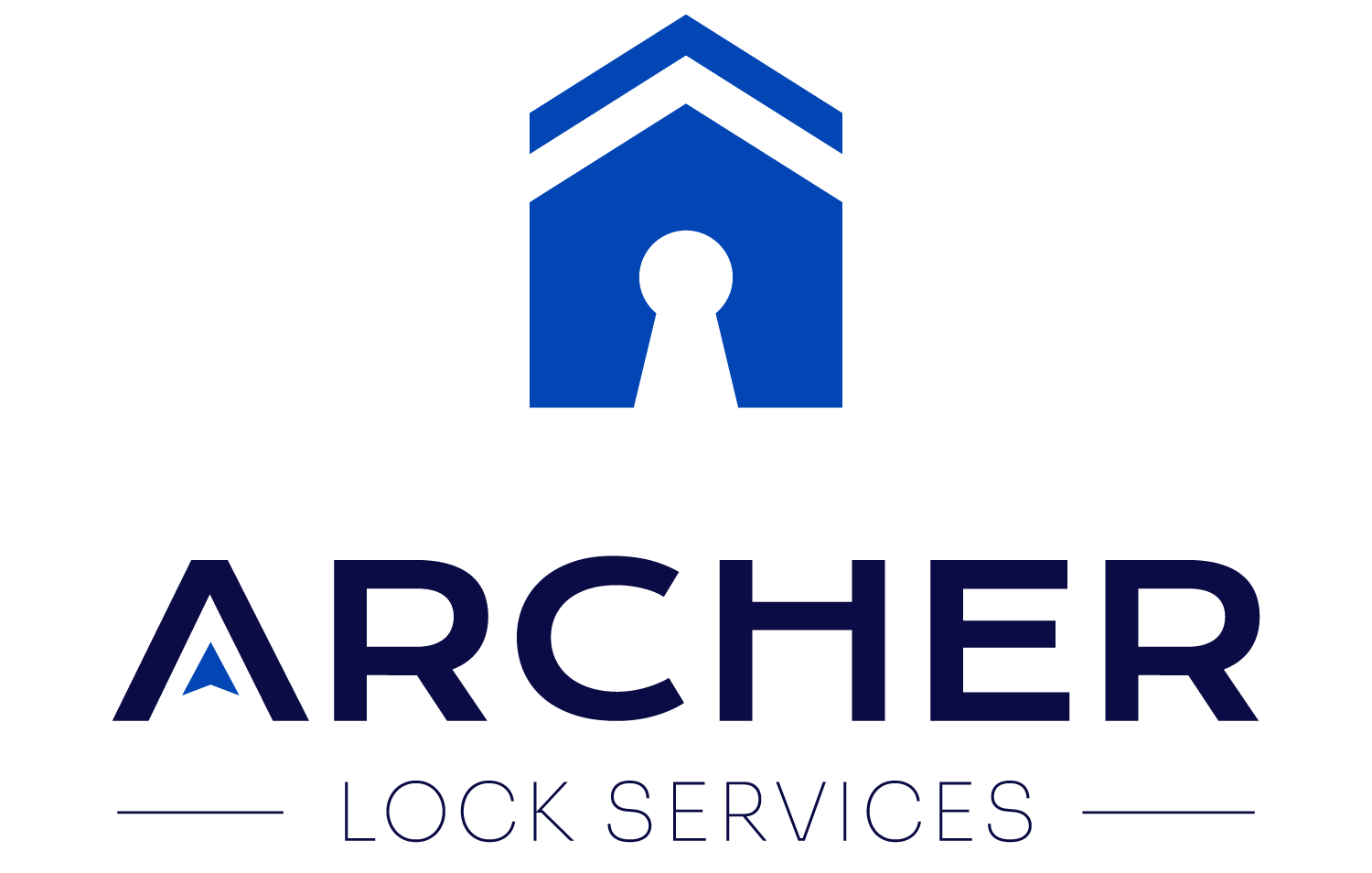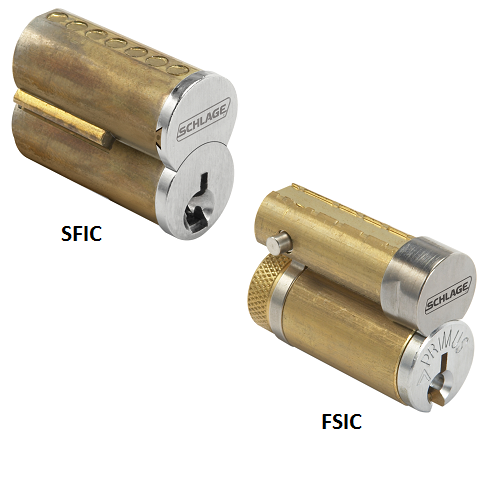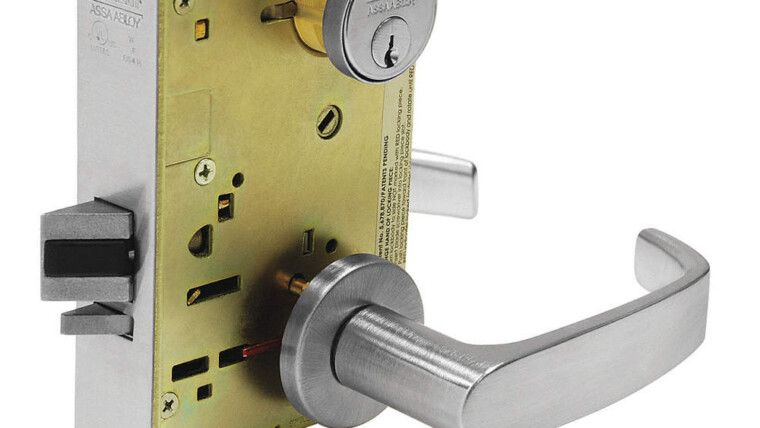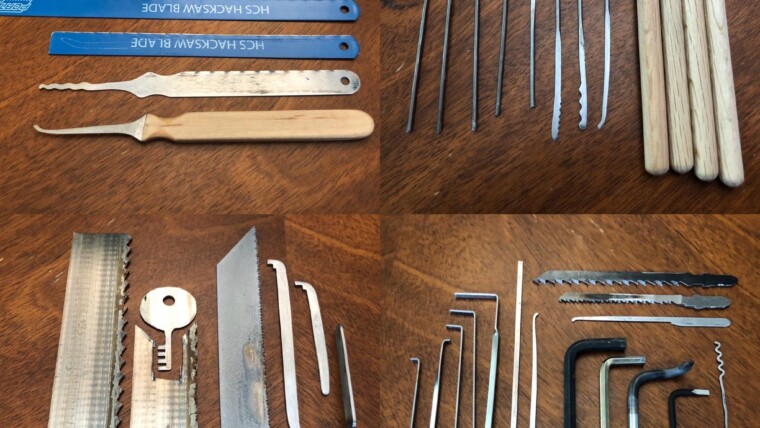Interchangeable Cores: What You Need to Know
One of the most popular key systems in the North American markets is the Interchangeable Core System. You may have seen them in both commercial and residential buildings with their distinctive figure-8 shape. Unfortunately, these types of locks can seem complicated. So here is what you need to know about Interchangeable Cores including the two most popular types plus the latest third version.
- Small Format Interchangeable Core (SFIC)
- Large Format Interchangeable Core (LFIC)
- Hybrid Interchangeable Core
As always, if you have any questions or comments, please call/text me at 604-363-2760 or email me at alex@locksmithvancouver.com. To duplicate keys and fobs, our Downtown Vancouver Key Store is open Monday to Friday 10am to 5pm. We also provide mobile service everyday from 8am to 11:30pm.
Brief History of Interchangeable Core Systems
Currently, the most popular type of lock in Canada and in the U.S.A. are cylindrical locks. These are the ubiquitous deadbolts/knobs/levers anyone can find at DIY stores like Home Depot and Lowe’s. However, cylindrical locks are a relatively recent invention and only entered the market in the early 20th century.
Before cylindrical locks, most locks were either mortised into the edge of the door and are still called Mortise Locks. Or they were surface mounted on the interior side of the door in the case of Rim Locks.
One of the unique differences between the older mortise/rim locks vs the “newer” cylindrical locks is that the former used mortise/rim cylinders fitted into a 1-¼” hole in the door.
Just like the modern times, people in the past wanted an easy way to rekey their locks. Unfortunately, the older locks were not exactly user friendly and in order to rekey a lock, one may need to spend considerable time dismantling the lock first.
So people began inventing ways to easily remove the key cylinder from the lock without special tools or knowledge and to reinstall later. Essentially, they wanted the modern equivalent of a “plug-and-play” system.
Earlier versions involved removing both cylinder and the cam which left only a thin round shell in the door. This caused problems as the shells could not stand much abuse and could be easily damaged.
In 1919, Frank Ellison Best invented a dependable removable core system that eventually turned into what we now call the SFIC system starting in the 1960’s. Even now the BEST Lock Corporation is synonymous with SFIC cores, locks, and keys.

Small Format Interchangeable Core (SFIC)
When Frank Best designed the SFIC system, he wanted to leave behind as much of the mortise/rim cylinder behind in the lock. As a result, he separated the cam mechanism from the cylinder. As a result, in a SFIC lock, the lock actuator is separate from the key cylinder making the whole lock much more modular.
So one of the main advantages with a SFIC or any IC system is that you can buy just the parts you need and not buy the parts you don’t need.
For example, glazing companies will often install locking glass door pull handles with the SFIC housings pre-installed as it’s an integral part of the handle. However, they will usually not provide a SFIC key cylinder unless asked for specifically. This is in order to save costs. In turn, most building managers will then order a set of cores from a Vancouver locksmith keyed to an existing master key system.
Once the key cylinders are ready, the building manager or locksmith just needs to walk around and insert the new cylinders with the Control Key.
FYI, most buildings using an IC system would usually have a few cores keyed up and ready to use as needed.
To illustrate, before the popularity of RFID card readers in the hospitality industry, a lot of hotels used SFIC mortise locks. If a guest failed to return a key or lost it, the maintenance would simply pop out the old cylinder and pop in a new one. No need to call a Vancouver locksmith everytime something like this happens.
After a while, enough old cylinders would accumulate and they would send a box of it to their locksmith of choice to rekey and send back for recirculation.
Similar cycles of operation could be found in mostly larger institutions like hospitals, universities, etc. If your organization is big enough to have a locksmith on staff, you probably have a SFIC system in your buildings.
Problems with the SFIC System
No system is perfect and a SFIC system has its share. A few of the biggest headaches with a SFIC system are the following:
- Unique keyways
- Complicated pinning structure
- Higher initial setup costs
Unique Keyways
BEST keyways are completely different and are not compatible with most other keyways. This is not usual in the lock industry. For example, you cannot create a master key system that uses both Schlage and Sargent keys. You have to use one or the other.
However, unlike “standard” keys which have shoulder stops, BEST keys are all tip stopped like your car keys. As a result, not only are the key shapes different, everything is the reverse of a standard key from the likes of Weiser, Kwikset, or Schlage.
Their key holes are quite odd as well. Some look radically different and are easy to identify. Others have such minute differences that sometimes the only way to identify the keyway is to insert the key into a plug and see if it goes in.
In addition, BEST keyways have no master key hierarchies which means you cannot expand a SFIC master key system by adding keyways from the same key tree like in a Schlage system.
If you are using the BEST A keyway, all your locks are going to be on the BEST A system. In contrast, in a Schlage key system, you can start with the C keyway and move all the way up the key tree to the L keyway.
For a large institution with hundreds of cylinders, this may be a problem as unintentional ghost keys could be a recurring problem. Also managing a master key system of that size would be quite burdensome.
Complicated Pinning Structure
Unlike a non-SFIC system, there is no easy way to rekey a SFIC core. There are three pinning systems and each has its rules and specifications. So with a SFIC system, you don’t usually ask a locksmith to come on-site to rekey the cylinder. SFIC pinning and rekeys are usually done at the shop where all the specialized equipment is located.
You will have to find three keys in every SFIC system which are:
- Master Key – works with all the SFIC cores in the system
- Control Key – allows the removal and insertion of cores in the system
- Change Key – unique to a particular cylinder and works only on that cylinder
One of the most frequent problems I encounter with a client’s SFIC system is that they have lost the Control Key that allows me to remove the old cylinder. This can be problematic because lockpicking a cylinder just to the Control Shear Line is very difficult.
The most common scenario is to drill out the core to remove it from the housing or destroy the lock to remove the core intact. If the core is removed intact, we have a technique that allows us to “decode” the Control Key. In this way, we can save the other SFIC cores and housings in the client’s possession.
Without getting bogged down in the weeds, the most popular version still in use today is called the A-2 SFIC system. If you are using the A-3 or the A-4 system, good luck trying to find a locksmith who deals with those.
Long story short, designing a pinning chart and actually pinning a SFIC core is way more complicated than a normal non-SFIC cylinder. For some reason, we do a lot of SFIC work and have gotten really good at it. However, it still takes longer and more equipment to pin up a SFIC key cylinder. So prepare for higher costs in maintaining a SFIC system.
Higher Initial Setup Costs
Besides higher upkeep costs, SFIC systems cost more upfront as well. SFIC locks and housing cost on average 25% to 40% more compared to non-SFIC locks. You will also need more ancillary parts to make the locks work properly.
You can save some money by choosing off-brand SFIC parts from companies other than BEST. However, in my experience, the off-brand SFIC parts are significantly worse than the BEST originals.
For example, the GMS SFIC cores are 50% cheaper than the BEST original key cylinders. However, all my clients remark or complain that the cheaper cylinders are far less smooth or long lasting as the BEST original cores. As a result, we now only use BEST original cores for all our SFIC projects.
After having keyed up and installed hundreds of SFIC cores over the years, the quality difference between the originals and the off-brands are significant.
So when designing your workspace, you should consider whether or not you really need a SFIC system. I would say most of my commercial and residential clients should not use a SFIC system. However, most of them just ended up inheriting a previously installed system and it was more economical to keep using it.
Large Format Interchangeable Core (LFIC)
As stated above, one of the issues that Frank Best ran into was that the IC core he invented had to reduce the size of all the keys and pins to fit into a more compact form. This meant that large existing companies like Schlage and Sargent had to use BEST’s keys and patents in order to stay in the IC market.
Eventually, these companies developed a larger IC system which their company’s keys can fit into. These larger cores and locks are called Large Format Interchangeable Cores. Schlage calls their LFIC system the Full Size Interchangeable Core System or FSIC, but it’s the same thing.
Differences between LFIC and SFIC
The biggest difference between an LFIC and a SFIC system is that the LFIC uses standard keys from that company’s suite of keyways. No more messing around with special pinning structures and weird do’s and don’ts.
You still need a Control Key to remove and insert a LFIC core, but it’s just a special key that is a bit longer with a “nose” at the tip. You don’t need to pin the core to a special Control Shear Line.
Since you can use just standard keys and pins, rekeys and other upkeep costs are cheaper as well. You don’t need a Vancouver locksmith with specialized knowledge in SFIC systems and special key cutting equipment.
Clients can also have much larger Master Key Systems that incorporate much more of the Keyway Hierarchy.
However, the biggest downside about LFIC systems is their lack of popularity and high upfront costs.
SFIC systems still dominate the IC market and LFIC are fairly rare. I probably see 1 LFIC system for every 10 SFIC systems. It probably depends on the region, but in Vancouver and the Lower Mainland, LFICs are fairly rare.
Due to its lack of popularity, most distributors do not carry a lot of stock in LFIC keys and parts. In addition, they cost more as there are less off-brand options. For example, GMS offers SFIC cores in 27 keyways. On the other hand, they only offer 6 LFIC core types.
Hybrid Interchangeable Core
A new IC product that recently became available in Vancouver is a hybrid system that uses an IC core in the size of a SFIC core but in a standard keyway like a LFIC. It basically allows a user to use the most popular standard non-BEST keys in the more widely used SFIC system.
It tries to combine the best of both worlds. In my experience, it also combines the worst of both worlds. The system uses smaller pins of very odd sizes to allow a Downtown Vancouver locksmith to pin a SFIC core to a normal sized non-BEST shoulder stop key. Plus, it’s not from a major manufacturer so all the quality issues of the off-brands are still there with subpar precision, materials, and finishes
It’s a super weird product, and I would not recommend any client use this hybrid system until it becomes a proven technology. Right now, it is so niche that only people in very specific use cases should even attempt to use it.
Conclusion
In this article we discussed the most common, less common, and super new Interchangeable Core systems available in the market. Generally, most clients will only ever encounter SFIC systems and LFIC once in a blue moon.
When using SFIC, I highly recommend clients to stick to BEST original key cylinders and locks. It’s like buying into the Apple ecosystem. They were designed to work together and they work well. If you start mixing parts from other brands, something is bound to suffer.
If you have any questions or comments about IC systems, please call/text me at 604-363-2760 or email me at alex@locksmithvancouver. IC systems are getting less popular these days with the availability of access control technologies like fobs and card readers. However, outside of an in-house institutional locksmith, we probably deal with SFIC and LFIC systems more than any other locksmith company in town due to our geographic location and depth of commercial clients.



